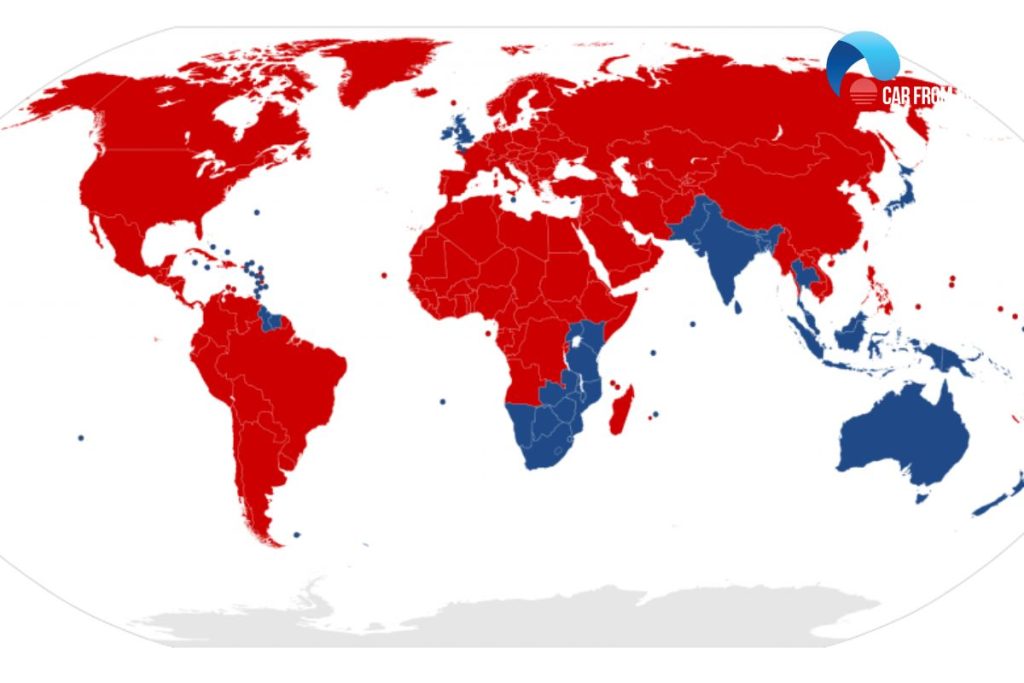Left hand drive vs right hand drive is a dilemma that many people cannot wrap their heads around.
Traveling from one country to another comes with a bundle of surprises – new culture, new people, different food, cultural shocks, and many more.
Another thing that could be included in this package is the driving rules – especially for those visiting from a right-hand driving country to a left-hand driving (LHD vs RHD) country or vice versa.
Contents
- Some Facts about Left Hand Drive vs Right Hand Drive
- Left Hand Drive vs Right Hand Drive, which one comes first?
- Left Hand Drive vs Right Hand Drive: The Reasons for Differences
- Left Hand Drive vs Right Hand Drive, which one is safer?
- Countries With Right-Hand Drive And Left-Hand Drive
- What Is the Current Condition?
- FAQs on Left Hand Drive and Right Hand Drive
- Is it true that right-hand drive cars are safer for overtaking in left-driving countries?
- Why did Japan and the UK both choose right-hand drive?
- Can a car be legally converted from RHD to LHD (or vice versa)?
- Why are RHD cars often cheaper to import into LHD countries?
- Why do some rally and drift drivers prefer RHD cars even in LHD countries?
- Are there any countries that allow both LHD and RHD vehicles on the road?
Some Facts about Left Hand Drive vs Right Hand Drive
Worldwide
Approximately 35% of the world’s population drives on the left. The countries that follow the left-hand drive rule are mostly old British colonies.
It will be a tad shocking for anyone when they visit a country like England, Bangladesh, or Japan from one of the 75% of the countries that adhere to the right hand driving
Accidents
According to one study, the incidence of accidents in countries with lower left-hand driving laws is lower than that of the right-hand drive countries.
African countries
In Africa, Mozambique – the former Portuguese colony – still retains the driving tradition on the left, although Portugal shifted to the right-hand drive in the 1920s.
The reason is that all the bordering countries are former British colonies and are influenced by the British style of driving.
Morover, for some African countries, Kenya more specifically, left-hand drive vehicles are not allowed except in cases of diplomats from left-hand drive car countries who want to bring their car.
In addition, vehicles with left-hand drive used in mining and construction are allowed to circulate.
Oceania
Another country in Oceania, Samoa, has also enacted a new law to adapt the South Pacific nations to the left-hand drive to adapt to other East African Community (EAC) countries.
Left Hand Drive vs Right Hand Drive, which one comes first?

The history of left walking comes from the Greek, Egyptian and Roman times and is more widely used than right walking.
From a habit, going left becomes a tradition and then becomes the law. The left-handed rule was well established in Rome by cities with dense traffic.
By sitting on the left, you will naturally want the person to go in the opposite direction also to their left so you can look down and make sure that under their wheels there is nothing suspicious.
For this reason, you are forced to go to the right of the road. The first law of the United States was introduced in Pennsylvania in 1792, and many years later, many other states and counties in Canada adopted the law.
Left Hand Drive vs Right Hand Drive: The Reasons for Differences
The automobile is a 20th-century invention. So, it seems confusing that there are two different standard systems for driving all over the world. Well, the car is a modern concept but the roads have been there for centuries.

In ancient Rome, people used to drive chariots. As most human beings are right-handed, the Romans chose the right-hand side of the road to drive so that they could hold the reins with their right hand and whip a horse with their left hand.
It also eliminated the risk of whipping a passing chariot but made it possible to attack a passing enemy with the right (stronger) hand.
The British people inherited that custom and later executed it in the colonies they ruled.
READ MORE: How to Drive Like a Pro in Heavy Traffic?
On the other hand, Henry Ford, the founder of the Ford Motor Company, was the pioneer in changing the driving side.
He designed his Model T with the left hand driving cars. It enabled the drivers to drive on the right, allowing the passengers to exit onto the pavement.
Mr. Ford started the clash between left hand drive vs right hand drive in which the former standard came out as victorious.
Many countries gradually followed this standard, with Spain, Italy, and Canada in the 1920s and most Eastern European countries in the ‘30s.
Left Hand Drive vs Right Hand Drive, which one is safer?
According to a study conducted in 1969 by J. J. Leeming, the countries applying the driving law on the left have lower rates of traffic crashes than those applying the right driving laws.
When driving on the left, the right eye with better power is used more to monitor the opposite direction of traffic and the rearview mirror near the driver.
In addition, some suggest driving on the left is safer for older people because it seems that aging results in decreased ability to focus on the left. Vehicles are moving to the left at intersections.
Countries With Right-Hand Drive And Left-Hand Drive

| Left hand drive | Right hand drive |
| – UK Territories and British Autonomous Region: Anguilla, British Virgin Islands, Cayman Islands, Falkland Islands, Isle of Man, Montserrat, St. Helena, Turks & Caicos Islands. – Asia: Bangladesh, Bhutan, Brunei, Hong Kong, India, Indonesia, Japan, Macau, Malaysia, Nepal, Pakistan, Singapore, Sri Lanka, Thailand. – Europe: Cyprus, Ireland and Northern Ireland, Malta, Scotland, Wales. – Africa: Botswana, Kenya, Lesotho, Malawi, Mauritius, Mozambique, Namibia, Seychelles, South Africa, Suriname, Swaziland, Tanzania, Tonga, Trinidad & Tobago, Rwanda, Zambia, Zimbabwe. – America: Antigua & Barbuda, Bahamas, Barbados, Bermuda, Dominica, Grenada, Guyana, Jamaica, St Kitts & Nevis, St. Lucia, US Virgin Islands, St. Lucia Vincent & Grenadines. – Oceania: Australia, Fiji, New Zealand, Papua New Guinea, Samoa, Solomon Islands. | The rest with red color in picture |
What Is the Current Condition?
It is obvious from the left hand drive vs right hand drive discussion that all the countries started driving on the right side of the road but most of them eventually switched sides.
Today, almost 50 countries still stick to the tradition of driving on the left. The only apparent reason for this stubbornness seems to be the unwillingness to change a tradition.
However, the logical cause is that left hand drive countries have designed their roads and cities to accommodate left-handed driving.
Changing the driving side is not a viable option for these countries because they have to alter the design of their cities.
FAQs on Left Hand Drive and Right Hand Drive
Is it true that right-hand drive cars are safer for overtaking in left-driving countries?
Yes. The driver’s position gives a clearer view of oncoming traffic when passing another vehicle.
Why did Japan and the UK both choose right-hand drive?
Both had traditions of left-side travel before cars existed, samurai and knights preferred to keep their dominant (sword) hand toward the middle of the road.
Can a car be legally converted from RHD to LHD (or vice versa)?
Yes, but it’s complex.
It involves relocating the steering column, pedals, dashboard, wiring harness, and sometimes the brake booster, and may not be legal in all countries!
Why are RHD cars often cheaper to import into LHD countries?
Because demand is lower. Driving a RHD car in an LHD country can be inconvenient or even restricted, reducing resale value and import prices.
Why do some rally and drift drivers prefer RHD cars even in LHD countries?
Because some JDM cars are only available in RHD, and the steering feedback or cockpit layout may be optimized for that configuration.
Are there any countries that allow both LHD and RHD vehicles on the road?
Yes. Places like Kenya, South Africa, and some Caribbean nations permit both, though import rules, toll booths, and overtaking laws can make one type more practical.

If you want to know more information about car industry knowledge, follow us for daily updated articles to satisfy your demands!




the content is wrong in some places
india is showing left-hand drive — it’s NOT TRUE !!!!!!!!!!!!!!!
Your terminology is fundamentally incorrect. The acronym “RHD” or Right Hand Drive refers to the position of the driver within a vehicle – i.e. the driver sits in the right hand seat. Australia, UK, much of Asia is RHD, not “LHD” as you’ve stated. “RHT” or Right Hand Traffic refers to the position of the vehicle itself on the road – such as where vehicles rive in the USA and much of Europe. Australia, UK, etc, conforms to the LHT rule.
I agree with Chris that the author is constantly getting LHD/RHD mixed up with LHT/RHT, which makes this article entirely confusing. To be honest, the best bit has to be near the start when the author states that “Approximately 35% of the world population drives on the left.”, followed by “..from one of the 75% of the countries that adhere to the right hand drive”. Not only does it show the misunderstanding above (since driving on the left is usually done with right hand drive vehicles) BUT somehow 35 + 75 equates to 100 🙂
It’a okay because the writer’s arithmetic is poor.
If traffic is driven on the left of the road then the driver sits on the right of the vehicle and vice-versa. I wonder why the driver gets himself all confused over such a simple matter. If he has to write about soemthing more complicating I guess he’d have to commit hara-kiri LOL.
I was more interested in the proportion of the driving population rather than the number of countries. Former British Empire islands sprinkled all over the world give a false impression by counting countries.
This article is a travesty of confused nonsense. Next time employ an editor.
HAHA, love these comments! My brain melted trying to read this utterly confusing article. Geez man, is it that hard?!
I thought it was just me, lol!
The Author confuses himself with Right Hand Drive and Right Hand Traffic. If a degree holder and in the car industry for over 20 years and to top it off a car enthusiast can make this simple mistake, It begs the question if he even knows what is right from wrong, oops i mean left.
Internet is like a minefield. You get information easily but sadly, some of them are wrong like this one. Imagine those who doesn’t know any better and it’s shocking such wrong info comes about without proper vetting.